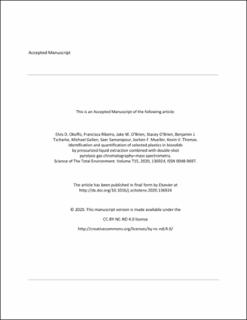Identification and quantification of selected plastics in biosolids by pressurized liquid extraction combined with double-shot pyrolysis gas chromatography–mass spectrometry
Okoffo, Elvis D.; Ribeiro, Francisca; O'Brien, Jake; O'Brien, Stacey; Tscharke, Benjamin; Gallen, Michael; Samanipour, Saer; Mueller, Jochen F.; Thomas, Kevin V
Peer reviewed, Journal article
Accepted version
Permanent lenke
https://hdl.handle.net/11250/2711102Utgivelsesdato
2020Metadata
Vis full innførselSamlinger
- Publikasjoner fra Cristin - NIVA [2160]
- Scientific publications [1172]
Sammendrag
The identification and quantification of selected plastics (polystyrene (PS), polycarbonate (PC), poly-(methyl methacrylate) (PMMA), polypropylene (PP), polyethylene terephthalate (PET), polyethylene (PE) and polyvinyl chloride (PVC)) in biosolids (treated sewage sludge) was performed by pressurized liquid extraction (PLE) combined with double-shot pyrolysis gas chromatography–mass spectrometry. Validation of the method yielded recoveries of between 85 and 128% (mean RSD 11%) at a linear range of between 0.01 and 2 μg. The distribution of plastics within 25 biosolid samples from a single wastewater treatment plant in Australia was assessed. The mass concentration of PE, PVC, PP, PS and PMMA was between 0.1 and 4.1 mg/g dry weight (dw) across all samples, with a total plastic concentration ƩPlastics of between 2.8 and 6.6 mg/g dw (median = 4.1 mg/g dw). PE was the predominant plastic detected (mean concentration of 2.2 mg/g dw), contributing to 50% of the total of all plastics. Overall, this study demonstrates that pressurized liquid extraction (PLE) combined with double-shot pyrolysis gas chromatography–mass spectrometry can be used to identify and quantify PE, PP, PVC, PS, and PMMA in biosolids.

